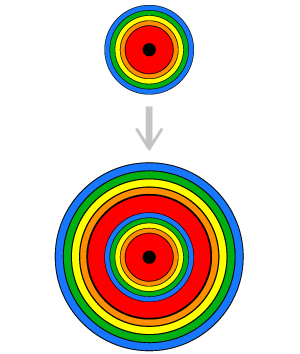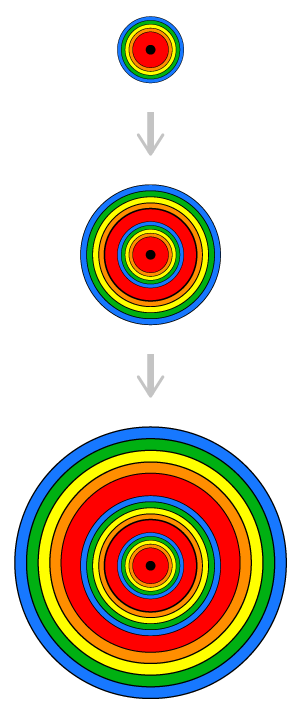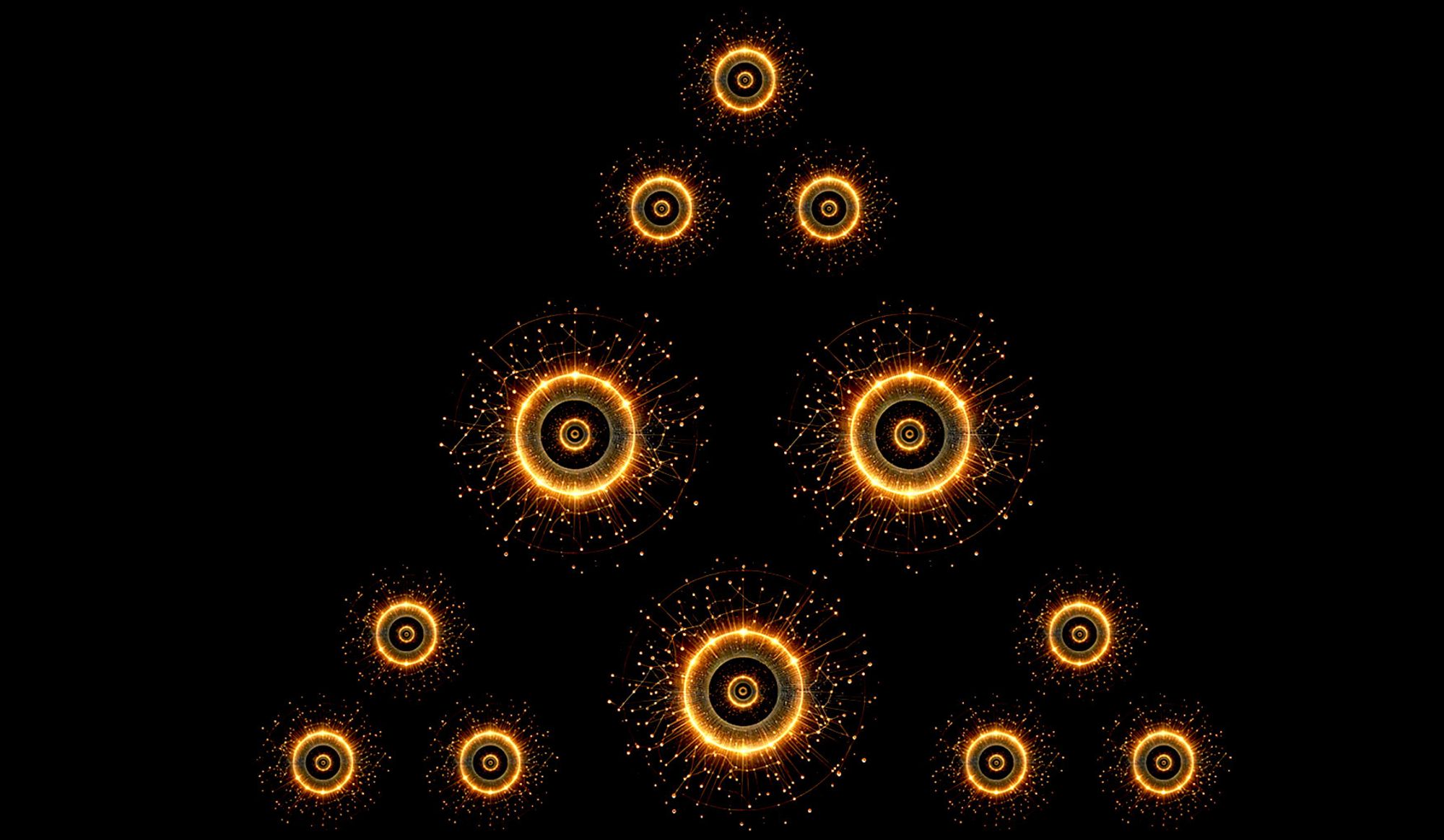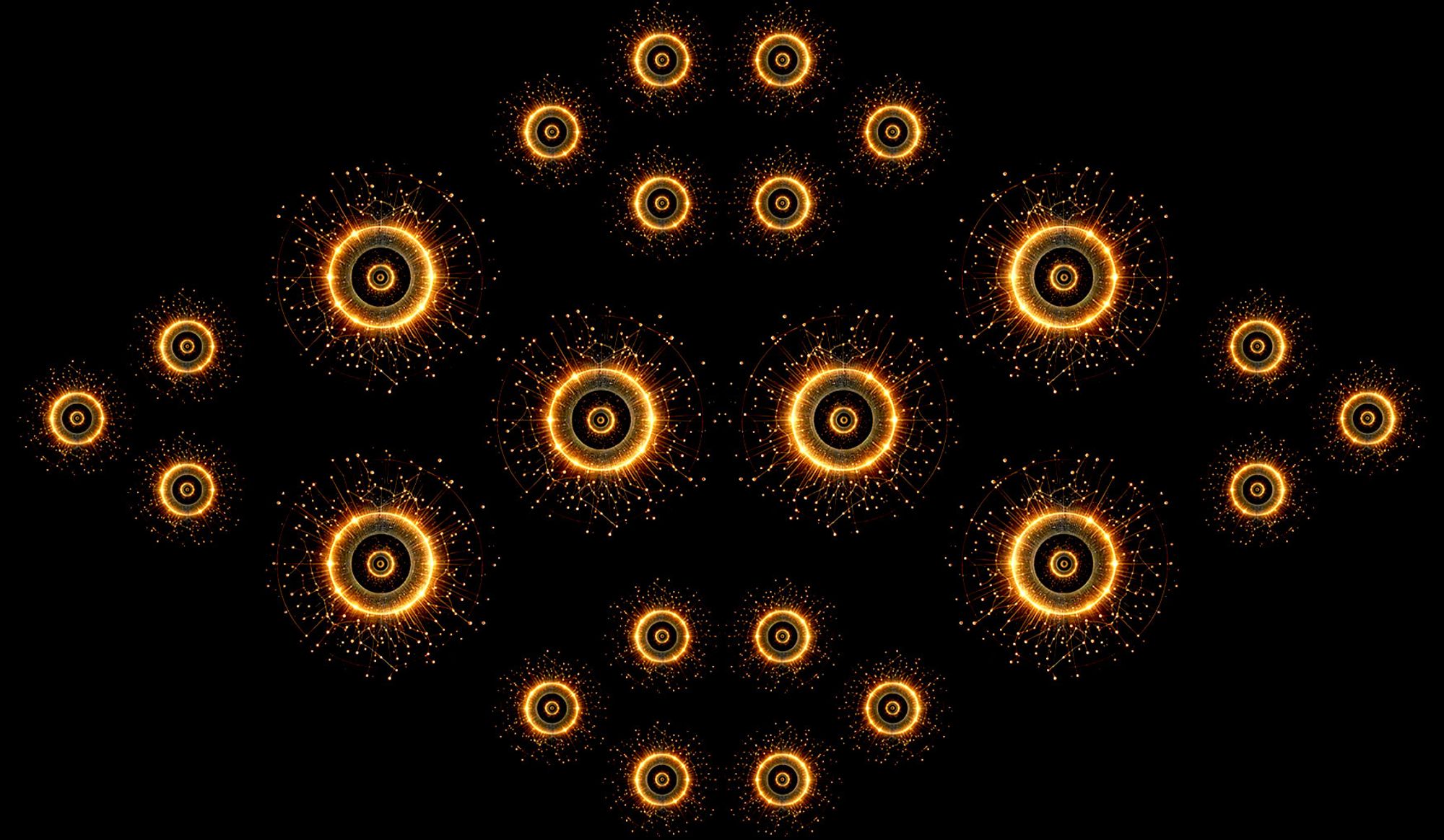Tiers of Intelligence

Advanced: The tiers of data within a bit
Everything you have learned previously on this page explains what data is and how a bit stores data.
This is just the first tier of data involved when you look at a single bit.
When you look at more bits than just one, you can access higher tiers of data.
Understanding how tiers of data work in a bit, is the key to unlocking superhuman intelligence with consciousness software.
The five tiers
The four additional tiers of data within a bit are essentially the same as the first tier you have already learned about.
Tier 1 – A single bit: Tier one data is the information involved within a single bit. You just learned what this data is, as well as the life cycle of a bit.
Tier 2 – Bit clusters: Tier two data is the information you become aware of when you look at multiple bits (bit clusters) at the same time.
Tier 3 – Data networks: Tier three data is the information you become aware of when you look at multiple bit clusters within a data network, at the same time.
Tier 4 – Collaborative networks: Tier four data is the information you become aware of when you look a multiple data networks at the same time.
Level 5 – Singularity: Tier five data is the information you become aware of when you look at multiple collaborative networks at the same time. This is who you are as a whole being.
The tiers of data are connected to your consciousness
When we are talking about bits, we can swap the word “data” for “consciousness”, and vice versa.
Your level of consciousness for any topic can be calculated by the number of bits and the tiers of data within those bits.
By optimizing the data stored within your memory, it’s possible to increase the number of tiers within a bit, as well as increase the number of bits you can view at once.
This is a process required to achieve superhuman intelligence.
Reading and writing tiers of data
In order for your brain to read and write tiers 2, 3, 4, and 5 data into a bit, you must be conscious of the data.
Your consciousness is limited based on the number of bits you can view at once, and your ability to access higher tiers of data.
Tier 2: The human standard
Tier two data is the standard level of consciousness for the average person.
This is because you automatically look at multiple bits of data associated with each thing in your life.
All of your bits are guaranteed to have a minimum of two tiers of data.
Tier two data is often associated with the wide spectrum of opposites, such as liking or disliking the thing that you are focused on.
Tier 3: The skilled worker
Tier three data is associated with a large scope and understanding of the complex details involving a single subject or skill.
For example, a skilled worker or consultant can assess a unique situation and create a custom solution out of a variety of options.
There is a systematic organization of data for tier three.
It’s not about liking or disliking, it’s about which data is most relevant for the unique problem, the desired outcome, and the skill required to complete the task.
Tier 4: The CEO Standard
CEOs work with larger amounts of data on a diverse range of topics to build and operate their business.
Tier four data is typically only written into bits if you are in charge of a complex project, such as building and operating your own business.
Coherence in the business becomes an obsession for the CEO, since the conflicts within the data cause immense stress and pressure, accelerating the speed that bits become damaged.
The higher the tier, the more intense the damage
Bits that store higher tiers of data produce higher energy destructive bits when they collapse.
These high-energy destructive bits produce the intense and severe burnout effects that CEOs experience.
Tier 2 Data: Bit Clusters

What is a bit cluster?
Bits that have the same purpose are organized together as bit clusters.
Within a single cluster, you can have functional, dysfunctional and destructive bits.
Bit clusters are primarily activated through the food you eat, emotional reactions, the actions you take, and the people you interact with.
The "cluster" data in a bit.
When looking at a bit cluster, you can see new data that wasn’t active when looking at an individual bit.
You can see the connections and conflicts with the data that is shared between multiple bits.
You can think of “cluster” data as a second level of consciousness that only exists when you look at multiple bits at the same time.
Tiers of data within a bit
The first and second tiers of data are stored within each bit.
However, tier two cluster data only activates when looking at a cluster.
Just like a single bit, every time you look at a cluster, your brain will write healthy and unhealthy data into all the bits active within the cluster.

Illustration of a functional bit with only tier one data active.
Then showing the second tier of "cluster" data that activates when looking at a bit cluster.
Cluster size regulates intelligence
If the size of the bit cluster increases, this enables you to see more connections and new conflicts within your information.
However, if the size of the cluster decreases due to unhealthy data, you will lose access to previous connections you made.
Emotional instability limits intelligence
Let’s say the functional bit cluster you are focused on, is made up of 1,000 bits in total.
All of the data involving the individual bits, as well as the tie two cluster data, generates an emotional output.
The quantity of bits within this cluster that you can access at one time, is limited by the emotional stability of the cluster.
For instance, out of the 1,000 available bits in the cluster, you might only be able to view a maximum of 70-80 bits at one time, because of the emotional instability.
This is an important key for achieving superhuman intelligence.
Remember, your current level of intelligence, is determined by the number of bits you can view at one time.
Making emotionally bad decisions
The emotion generated from the bits within the cluster determines the maximum amount of bits that you can view at once.
Emotional stability = Higher number of bits
Emotional instability = Lower number of bits
When you are highly emotional, the amount of bits you can access within the cluster shrinks.
This results in making bad decisions because you lose access to the full scope of your information.
Later on, once you have calmed down, you wonder how you could have made such an irrational decision.
By stabilizing your emotional state, you can access a larger quantity of bits within a cluster.
Bit clusters divide based on conflicting data
A big cluster can divide into two or more clusters as a result of conflicting information.
Each of the separated clusters will produce a unique emotion with the data that supports that emotion.
Angry bits, sad bits, confused bits, passionate bits, excited bits, confident bits, etc… all naturally arrange themselves into separate bit clusters.
This is how you can have so many different and even conflicting perspectives about just one topic.
A quick university example
Have you ever been excited and sad about the same thing at the same time?
For instance, pretend you just got accepted into the university you wanted to go to.
You’re excited to go, and at the same time, you feel sad about leaving your family behind.
This data is organized as two separate bit clusters, because the data within them is conflicting, producing two different types of emotion.
Tier 3 Data: Data Networks

Data networks are a vital system for memory
A data network is responsible for creating new bits and organizing them into bit clusters.
A single data network can store hundreds of unique bit clusters associated with just one thing.
Three tiers of data within a bit
The first, second, and third tiers of data are stored within each bit.
However, the tier three data only activates when looking at more than one bit cluster at a time.
Generating tier three data
New tier three data is generated when looking at multiple bit clusters at the same time.
When looking at multiple bit clusters, you will see new connections as well as conflicts between the information.
This new information is recorded into all of the bits that are active within each cluster, as tier three data.
Not a typical experience
Looking at an entire data network at once, which can consist of ten’s to hundreds of bit clusters, is an extremely rare occurrence. (This typically only occurs when using high energy stimulants.)
It takes a massive amount of energy to be able to see that much conflicting data at one time.
Even looking at two or three bit clusters at one time is not a typical experience, unless you are a scientist or entrepreneur who is constantly solving complex problems.
The amount of energy it takes to activate several bit clusters at one time, can quickly lead to burnout.

Illustration showing tiers one, two, and three activated within a bit.
Let's go back to the university example
Creating the data network, new bits and bit clusters
When you were first thinking about going to college, your brain created a new data network for the action of going to college.
The first bits that were written into the data network were based on the reasons why you wanted to go to college.
All of the information associated with you going to college generated emotions.
Your brain organizes all of the bits within this data network, into separate bit clusters based on the emotions generated.
You had a list of reasons to be excited, and another list of reasons that made you feel sad.
A burst of energy activating multiple bit clusters
When you opened up the envelope and discovered that you were accepted into university, a massive amount of energy activated inside of you.
This explosion of energy activated the entire data network, consisting of many conflicting bit clusters.
You are super excited to go, angry that one of your other friends wasn’t accepted, sad to leave your family, and overwhelmed at the thought of moving and having to rent a place in a new city.
This explosion of energy enabled you to see many different bit clusters at once and feel so many different emotions at the same time, generating tier three data to be written into your bits.
Tier three data is generated when looking at multiple bit clusters within a data network at the same time.
Coming back down
Later on, when your energy calms down, you can focus on just one bit cluster at a time.
- You felt excited when you talked to your friend who is going with you.
- You expressed your anger when you talked to your other friend that didn’t get accepted.
- You felt sad when you talked with your family because you were going to miss them.
- You felt overwhelmed as you looked at all the stuff in your room and searched online to find a place to live.
During these lower energy moments, your brain will only write tier one and two data since you are only focusing on one bit cluster at a time.
While in a lower energy state, you will lose access to the higher energy tier three data within your bits.
A quick review
Earlier, you learned that the standard level of human consciousness is at tier two.
When we get these energy spikes, our brain becomes excited and will temporarily activate a higher tier of data.
In this university example, the energy burst activated tier three data.
The energy we feel drops down from tier three to tier two as a result of the conflicting data.
The higher energy state is not sustainable due to the conflicts in information, causing instability.
In order to naturally increase your energy level, the conflicting information within the data network must either be deleted or resolved.
Tier 4 Data: Collaborative Networks

Complexity organized with collaborative networks
Collaborative networks are created for complex things that your life revolves around, like a relationship, job or the most complex collaborative network, a business.
Your brain uses collaborative networks to organize large quantities of complex data.
To generate and access tier four data, you have to be looking at multiple data networks at the same time.
The connections and conflicts that you see between data networks is stored as tier four data.
The family unit is a natural collaborative network that produces tier four data.
For work, tier four data is typically only generated in people that manage complex projects or part of the executive team that overseas the business operations.
A collaborative network is made up of one primary network and many sub-networks.
For instance, you can think of your family as a primary network.
All of the people living in your home, as well as the objects within your home, are considered sub-networks.
The activities that you and your family members do in your home are also classified as sub-networks.
Primary networks
Primary networks are important as they command a lot of power over your life.
Your primary networks define your values during each phase of your life.
As you age, your primary networks typically change.
For instance,
- When you are young, your parents and siblings are your primary networks.
- When you are a teenager, your best friends and school are your primary networks.
- When you are an adult, your career, spouse, and children become your primary networks.
A sport, hobby or specialized skillset can also be considered a primary network, based on how much you prioritize your life around it.
If you are an Olympic athlete, then your sport has been your primary network for almost your entire life.
Using levels to classify sub-networks
A primary network is classified as level 1. This would include your business or spouse.
Sub-networks are smaller data networks directly linked to one or more primary networks.
For instance, Your business (level 1), will be associated with many different sub-networks (level 2).
You will have level 2 sub-networks for each division of your business, such as marketing, customer support, product development, HR, and the executive team as a whole.
Then each level 2 sub-network will connect with even smaller level 3 sub-networks for the individual people, processes, software, data, etc… that are involved.
This is the mechanism your brain uses to organize multiple data networks within a collaborative network.
Primary and sub-network relationships
Sub-networks are used by your brain to establish relationships between your data.
The health of a primary network such as your job, is also influenced by every level of sub-networks associated with it.
For instance, if you quit your job that you hated at your old company, and then got a new job at a new company, your brain will create a new primary network for the new job.
When you are in the new primary network it feels great, it’s clean with all new functional bits.
However, if your position entails the same skills and responsibilities as your previous job, you aren’t going to be happy.
As soon as you use those same skills at your new job, the associated sub-networks will transfer over to your new primary network, negatively affecting its health and functionality.
Within a few months, the health of the primary network for your new job can drop to a dysfunctional or even destructive state, depending on the health of the sub-networks.
Stress fractures
Unhealthy sub-networks cause stress fractures within your collaborative network.
When too many sub-networks are active at once, the conflicting data within them causes intense emotional stress and pressure.
For CEOs, their entire business is a massive collaborative network that can contain hundreds or thousands of sub-networks.
The more complex the business is, the faster unhealthy data will be written into your bits.
The compounding of unhealthy data in tier four bits, is the primary reason why CEOs struggle so badly with burnout.
Burnout is the result of your primary and sub-networks descending into dysfunctional and destructive states that can no longer produce functional bits.
Tier 5 Data: The Singularity

The Singularity - also known as Individual Reality
When you look at multiple collaborative networks at the same time, you will see new connections and conflicts between each major area of your life.
This information is stored as tier five data within your bits.
Each individual collaborative network can be thought of as a unique identity for who you are.
The people you work with, don’t know the person you are when you hanging out with friends, or the person you are while at home cuddled up in bed with your spouse.
Having several different personas that make up an individual’s whole self is normal.
The instability of tier five data
Tier five data is the most unstable because of the amount of energy it requires to maintain it.
As a result, tier five data is rare and circumstances that do generate a lot of tier five data usually end up in disaster.
For instance, if you, your spouse and children all run a complex family business together with a bunch of employees, this will produce a lot of tier five data.
When collaborative networks collide, the quantity of data that can conflict exponentially rises.
These conflicts produce extreme amounts of stress and pressure that accelerate the collapse of your bits.
In the corporate world, office romances are highly discouraged, because of the drama that is generated as the couple’s bits become destructive.
Birth to Age 4
When you are born, to approximately age four, your memory operates as a singularity.
The majority of your data is stored in tier five bits.
As you age, you accumulate more data, causing the singularity network to divide.
The singularity network is divided into two main collaborative networks.
The first collaborative network has to do with what the child does for his/her self.
The second collaborative network is what the child will do for other people such as parents and siblings.
These two collaborative networks are often referred to as your personal and professional life when you are an adult.
As you age, these two collaborative networks will continue to sub-divide further as a result of unhealthy and conflicting data.
Psychedelics
By using psychedelics, it’s possible to generate enough brain power to access previous tier five data, as well as write a lot of new tier five data.
The pure form of love that is associated with a psychedelic state occurs from your ability to connect back to data when you were a young child.
Psychedelics will also write a massive amount of data into the fifth tier of your bits.
When you come down from the high, the majority of the information you discovered fades away and you lose access to it.
This is a result of your brain no longer having enough brain power to access tier five data.
Corrupting singularity data
The tier four and tier five bits that were created when you were a young child, are used by your brain to ensure you are able to take care of your basic needs.
When using psychedelics, your brain will write new unhealthy data into these bits, permanently damaging them.
The loss of the self can occur as a result of this damage.
This shows up as a struggle when trying to manage basic human functionality, such as showering, keeping a scheduled routine, or completing basic tasks necessary for a job.
Resetting your brain
Psychedelics used for mental health issues use the term “Reset” when talking about the results.
When taking psychedelics the following occurs:
1. The drugs will target damaged bits.
2. You can see many new connections about your life and the information associated with the damaged bits.
3. The destructive bits are written with massive amounts of tier four and tier five data, causing them to merge into high energy destructive bits.
When you come down from the drug, you lose access to those destructive bits, since they now exist in a high energy state.
This is the process that occurs during the reset.
No trauma was removed or unhealthy data deleted. In fact, what happened is quite the opposite.
The amount of unhealthy data produced from the drug causes bits to collapse at an extremely accelerated rate.
The high intensity pressure causes low energy destructive bits to merge together into a high energy state.
Autoimmune disorders
Tier four or five high energy destructive bits have a massive amount of energy that can negatively affect your physical health.
When a low energy destructive bit becomes a high energy destructive bit, a mental health issue has been escalated into a physical health issue.
Autoimmune disorders, where your brain attacks your body, are the result of tier four and five destructive bits.
Tier five destructive bits are far more destructive than tier four destructive bits.
Childhood trauma
Childhood traumas that generate tier four or five destructive bits can also be devastating for a child.
Mental and physical health challenges that will last a lifetime, typically occur within the first ten years of a child’s life.
Autoimmune disorders and neurological disorders are the result of high energy destructive bits as a result of childhood trauma.
Tier five damaged bits will inhibit cognitive development, making it difficult for the child to adjust to normal life.
Revitalizing your mental and physical health
The life cycle of a bit cannot be reversed.
Once the bit becomes dysfunctional or destructive, it’s considered permanently damaged.
However, the health of a data network can be restored back to a healthy and functional state by deleting dysfunctional and destructive bits using consciousness software.
Deleting Bits with Consciousness Software
Increasing the brain power for a data network can be accomplished by deleting dysfunctional and destructive bits.
Consciousness software can delete up to six types of bits that are reducing the brain power in every data network.
By deleting these bits, the available brain power within the data network will increase, restoring it back to a functional state.
Deleting high energy destructive bits
As you restore the health of your primary data networks, your brain will automatically begin reconnecting the sub-networks.
This process will revitalize your collaborative networks, raising your consciousness up to access tier four data.
This will enable you to access and delete tier four destructive bits.
The same process will also provide access to tier five destructing bits as multiple collaborative networks reach healthier states.
What does memory editing actually do?
By automating the memory editing process, you can free up massive amounts of brain power.
Brain power is the energy within a bit that enables you to use your information.
When you run out of brain power, your life becomes a struggle.
To learn how brain power relates to your daily life, click the link below.